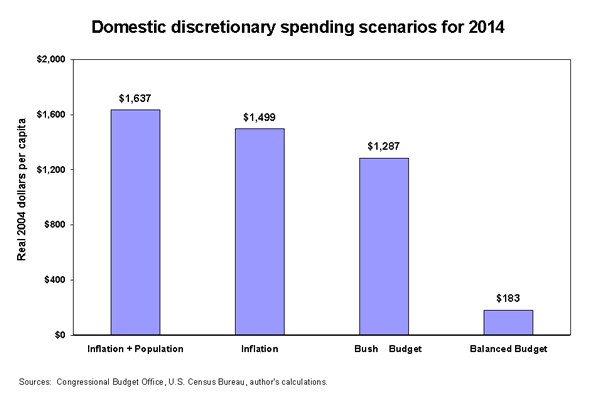See Snapshots Archive.
Snapshot for October 13, 2004.
This Snapshot is based on the EPI Briefing Paper The Budget Arithmetic Test: Repairing Federal Fiscal Policy by Research Director Lee Price and economist Max B. Sawicky.
Unrealistic expectations for the federal budget
At $415 billion for fiscal year 2004, the federal budget deficit was higher than at any other point in U.S. history. However, as pointed out nearly a year ago by Eugene Steuerle of the Urban Institute (2003), adopting the goal of a balanced budget in 10 years implies an utterly untenable fiscal policy that would require discretionary spending outside of defense and homeland security to be cut by nearly 90% in inflation-adjusted, per capita terms.
Non-security discretionary (NSD) spending encompasses domestic programs outside the categories of defense, homeland security, entitlements such as Social Security, and interest payments. NSD spending also includes public services funded by the federal government in the areas of education, environment, law enforcement, housing, economic development, energy, agriculture, housing, and health. It includes grants to state and local governments for similar purposes.
The figure below shows alternative scenarios for the federal budget. Over the past 20 years, domestic discretionary spending has grown at roughly the same pace as the gross domestic product (GDP). Over the next 10 years, annual growth of real GDP is expected at 2.9% annually, and population growth of 0.9%. Using a conservative standard of assuming that real NSD spending grows as fast as population, the figure shows a level of spending in 2014 of $1,637.

The second bar shows per capita spending of $1,499, assuming that current spending is adjusted for inflation, but not for population growth. This implies fewer dollars relative to the likely levels of service needed.
The third bar shows the implications of President Bush’s 2005 budget, as estimated by the Congressional Budget Office (CBO)—NSD spending of $1,287 per capita. The cut relative to the constant per capita standard is 21%. In other words, relative to current levels, the proposed Bush budget would require program cuts of 21% in 2014.
This 21% cut in domestic discretionary spending would be very high by historical standards. At the same time, such a cut would be utterly inadequate for balancing the budget in 10 years, a goal apparently shared by both presidential candidates. In fact, balancing the budget in 10 years through cuts in domestic programs would require implausible reductions of 89% in real per capita domestic discretionary spending.
The reality is that the federal government will need to accept a combination of moderate deficits, cuts in defense and entitlements, and tax increases, all options that no politician seems prepared to face today.
Source: Eugene Steuerle, “The Incredible Shrinking Budget for Families and Children,” National Budget Issues. No.1, The Urban Institute, December 2003.
This week’s Snapshot was written by EPI economist Max B. Sawicky.
